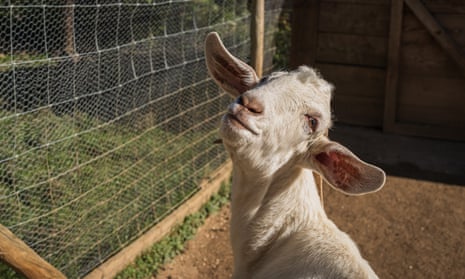It might not be animal communication Dr Dolittle-style, but researchers have found humans are able to glean insights into the feelings of creatures including pigs, horses and goats based on their vocalisations.
The team say the findings suggest certain information within sounds, such as how intense an animal’s emotions are, appears to be conveyed in a similar way across species.
“[People] probably base their decisions on their knowledge of how humans sound when they’re more or less aroused … because arousal, which is linked to stress pathways, is a system that is well conserved across vertebrates,” said Dr Elodie Briefer, co-author of the research from the University of Copenhagen.
They also looked whether people could determine whether an animal was expressing a positive or negative emotion.
“We cannot really rely on what we know from humans because it varies a lot between species – there are lots of differences in how species express emotions, even closely related ones,” said Briefer.
Writing in the journal Royal Society Open Science, Briefer and colleagues report how they recorded vocalisations from six animal species – horses, pigs, goats, cattle, Przewalski’s horses (wild horses) and wild boars. The team noted whether the sound was made when the animal was aroused – as determined by a high heart rate or movement – and whether the sound was made in a positive context, such anticipating food, or a negative context, such as being isolated.
For humans, the team used existing recordings of meaningless strings of speech spoken in rage or in fear to represent higher and lower emotional intensity – or arousal – respectively, and in an angry or joyful way to suggest a negative or positive context.
The researchers then asked 1,024 participants from 48 countries to each listen online to pairs of the sounds.
For each species, participants were played four pairs of vocalisations. For two pairs they were asked to rate the emotional intensity of the sound as high or low, while for the other two pairs they were asked to rate the emotion as positive or negative.
The results reveal that, overall, participants correctly rated the emotional intensity of the subject 54.1% of the time, and type of emotion 55.3% of the time.
However when the team analysed the data further, they found the participants only did better than chance on both metrics when assessing vocalisations from pigs, horses, goats, humans, and – for type of emotion only – wild boars.
“People are in general better at recognising domestic than wild species,” said Briefer.
The arousal level of pigs and horses was rated correctly 59% and 58% of the time respectively, compared with 55% for humans, while their type of emotion was rated correctly 58% and 64% of the time respectively, compared with 68% for humans.
“We’re quite confident that when it is higher than chance it is definitely higher than chance,” said Briefer, adding that while ratings might have been high for horses because many participants reported contact with such animals, the relatively low success rate for most species, including humans, could be down to both the brevity of the recordings, and the use of the same type of sound for each pair of vocalisations – such as mooing for cows or whinnying for horses.
Briefer added participants’ success in rating the type of emotions varied far more than their ability to determine the intensity of the emotions.
“If we take it to the next level, we can very likely easily train people to recognise the sounds,” she said, noting that could help those working closely with animals – from farmers to pet owners – to understand them better.
“In the past, scientists used to focus on physical health for assessing animal welfare. Nowadays, most of us recognise the large role that emotions play.”









